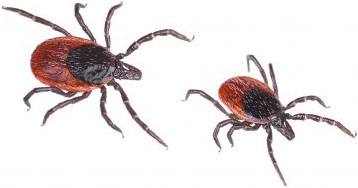
Blacklegged Tick (Ixodes scapularis)
WHERE FOUND: Widely distributed across the eastern United States, especially the Northeast, Upper Midwest, and mid-Atlantic.
BEHAVIOR: Passive, waits and quests to latch on to passing prey.
ACTIVITY: The blacklegged tick is active any time temperatures are above freezing. It is most active in the spring, summer, and fall. All lifecycle stages (larvae, nymphs, adults) bite humans.
TRANSMITS:
- Anaplasma phagocytophilum (anaplasmosis)
- Babesia microti (babesiosis)
- Borrelia burgdorferi and B. mayonii (which cause Lyme disease)
- B. miyamotoi disease (a form of relapsing fever)
- Ehrlichia muris eauclairensis (ehrlichiosis)
- Powassan virus (Powassan virus disease)
- Tick paralysis
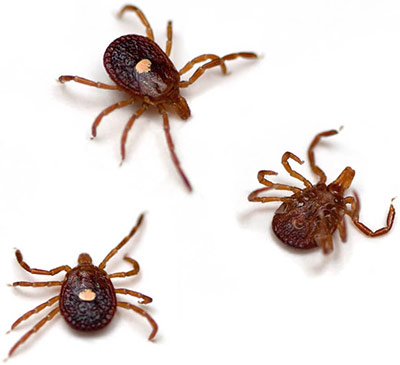
Lone Star Tick (Amblyomma americanum)
WHERE FOUND: Widely distributed in the south and eastern United States. Hotspots found across Arkansas, Georgia, Kansas, Kentucky, Long Island New York, Tennessee, North Carolina, Oklahoma, and Virginia.
BEHAVIOR: Aggressive hunter. Seeks out and runs toward prey by sensing CO2 and rudimentary eyesight. ALL LIFE CYCLE STAGES bite humans.
ACTIVITY: The lonestar tick is most active during warm months when the temperature is over seventy degrees. In the south this is usually from March through October.
TRANSMITS:
- Alpha-gal Syndrome, also known as the “Red Meat” allergy
- Bourbon virus (Bourbon virus disease)
- Ehrlichia chaffeensis and E. ewingii (which cause human ehrlichiosis),
- Francisella tularensis (tularemia)
- Heartland virus (Heartland virus disease)
- Southern tick-associated rash illness (STARI)
- Spotted Fever Rickettsiosis
- Tick paralysis
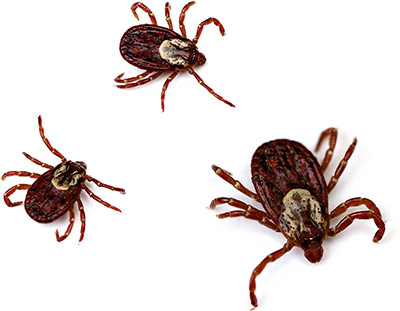
American Dog Tick (Dermacentor variabilis)
WHERE FOUND: Widely distributed east of the Rocky Mountains. Also occurs in limited areas on the Pacific Coast.
BEHAVIOR: Adults are most likely to bite humans. Bites mostly during spring and summer.
TRANSMITS:
- Francisella tularensis (tularemia)
- Rickettsia rickettsii (Rocky Mountain spotted fever).
- Tick paralysis
Other ticks in the U.S. that bite humans:
Blacklegged Tick (Ixodes pacificus)
WHERE FOUND: In the Pacific Coast states.
BEHAVIOR: Larvae and nymphs often feed on lizards, birds, and rodents, and adults more commonly feed on deer.
ACTIVITY: All life stages bite humans.
TRANSMITS:
- Anaplasma phagocytophilum (anaplasmosis)
- B. burgdorferi (Lyme disease), and very likely B. miyamotoi (Borrelia miyamotoi disease, a form of relapsing fever)
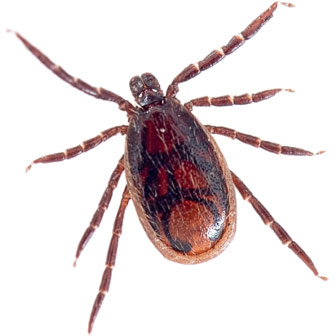
Brown Dog Tick (Rhipicephalus sanguineus)
WHERE FOUND: Worldwide. In the United States, primarily in the southwestern region and along the U.S. – Mexico border.
BEHAVIOR: Dogs are the primary host for the brown dog tick in each of its life stages, but the tick may also bite humans or other mammals.
ACTIVITY: TBD
TRANSMITS:
- Rickettsia rickettsii (Rocky Mountain spotted fever).
Groundhog Tick (Ixodes cookei)
WHERE FOUND: Throughout the eastern half of the United States.
BEHAVIOR: All life stages feed on warmblooded animals, including groundhogs, skunks, squirrels, raccoons, foxes, weasels.
ACTIVITY: Occasionally bites humans and domestic animals.
TRANSMITS:
- Powassan virus (Powassan virus disease).
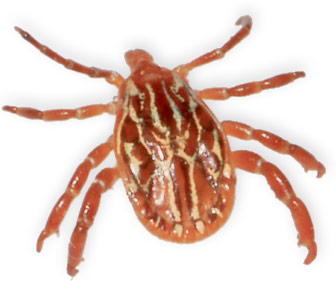
Gulf Coast Tick (Amblyomma maculatum)
WHERE FOUND: Southeastern and mid-Atlantic states and southern Arizona.
BEHAVIOR: Larvae and nymphs feed on birds and small rodents. Adult ticks known to feed on deer, other wildlife, and humans.
TRANSMITS:
- R. parkeri (R. parkeri rickettsiosis), a form of spotted fever.
Gulf Coast Tick Image: Courtesy BugGuide.net
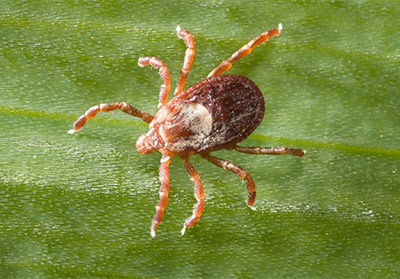
Rocky Mountain Wood Tick (Dermacentor andersoni)
WHERE FOUND: Rocky Mountain states.
BEHAVIOR: Adult ticks feed primarily on humans and other large mammals. Larvae and nymphs feed on small rodents.
TRANSMITS:
- Colorado tick fever virus (Colorado tick fever)
- Francisella tularensis (tularemia)
- Rickettsia rickettsii (Rocky Mountain spotted fever)
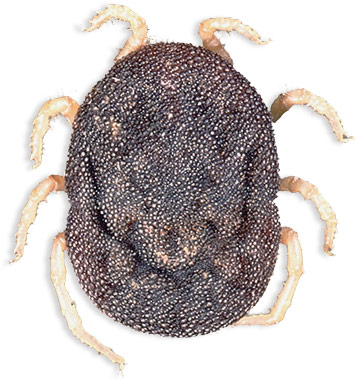
Soft Tick (Ornithodoros spp.)
WHERE FOUND: Throughout the western half of the United States, including Texas.
BEHAVIOR: Humans typically come into contact with soft ticks in rustic cabins. The ticks emerge at night and feed briefly while people are sleeping. Most people are unaware that they have been bitten. In Texas, TBRF may be associated with cave exposure.
TRANSMITS:
- Borrelia hermsii
- B. turicatae (tick-borne relapsing fever [TBRF])
Soft Tick Image: Courtesy Wikipedia, Alan R. Walker
This material is compiled from multiple respected sources, from TBC United research, and from the experiences of TBC United community members. While we work hard to ensure relevancy and currency, we cannot guarantee the accuracy of all information presented on this or associated (linked) web sites. The content is offered to provide practical and useful information on the subject matters covered. It is being presented with the understanding that TBC United is not engaged in rendering medical or other professional services. If medical or other expert assistance is required, the services of a licensed physician should be sought. If you choose to use preventive products on yourself, your loved ones, or your pets, carefully read and follow your medical professional and manufacturers’ recommendations.
Contact Us

Tell us how we can help.
Please provide your contact info and brief details and we'll respond within one business day, or sooner.
